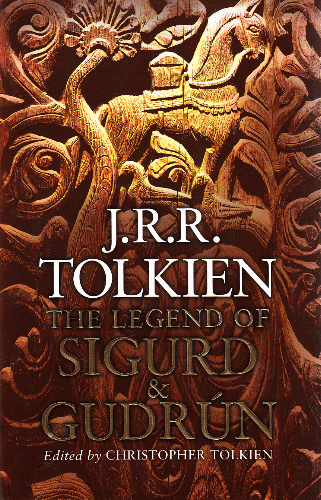Links to Bibliographies
The Big Three
--- Isaac Asimov
--- Arthur C. Clarke
--- Robert A. Heinlein
J.R.R. Tolkien
--- Introduction
--- Bibliography
Science Fiction and Fantasy Series
SF Universes and Fantasy Worlds
| Back to previous page | Record Number: 21880 | |||||

Edited by Christopher Tolkien First Edition 2009 HarperCollins London ISBN 9780007317233 Hardback in dust jacket Jacket illustration based on carvings on the doors of the 12th century church of Hylestad in Norway vi, 378 pages Price: £18.99 Notes
The half titles to sections are illustrated by Bill Sanderson. A page from the manuscript of The New Lay of Gudrún appears as a frontispiece.
Blurb – Dust Jacket Flaps “In the Lay of the Völsungs is told the ancestry of the great hero Sigurd, the slayer of Fáfnir most celebrated of dragons, whose treasure he took for his own; of his awakening of the Valkyrie Brynhild who slept surrounded by a wall of fire, and of their betrothal; and of his coming to the court of the great princes who were named the Niflungs (or Nibelungs), with whom he entered into blood-brotherhood. In that court there sprang great love but also great hate, brought about by the power of the enchantress, mother of the Niflungs, skilled in the arts of magic, of shape-changing and potions of forgetfulness. ”In scenes of dramatic intensity, of confusion of identity, thwarted passion, jealousy and bitter strife, the tragedy of Sigurd and Brynhild, of Gunnar the Niflung and Gudrún his sister, mounts to its end in the murder of Sigurd at the hands of his blood-brothers, the suicide of Brynhild, and the despair of Gudrún. In the Lay of Gudrún the fate after the death of Sigurd is told, her marriage against her will to the mighty Atli, ruler of the Huns (the Attila of history), his murder of her brothers the Niflung lords, and her hideous revenge.
“Deriving his version primarily from his close study of the ancient poetry of Norway and Iceland known as the Poetic Edda (and where no old poetry exists, from the later prose work the Völsunga Saga), J.R.R. Tolkien employed a verse-form of short stanzas whose lines embody in English the exacting alliterative rhythms and the concentrated energy of the poems of the Edda.” |
||||||
|
| ||||||
|
||||||



